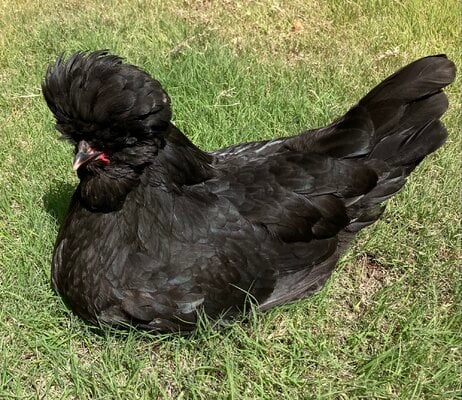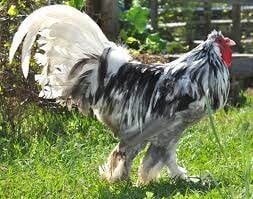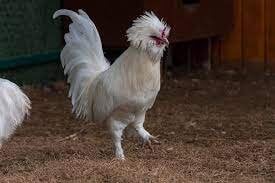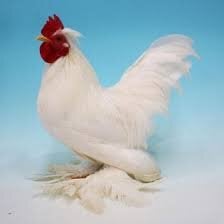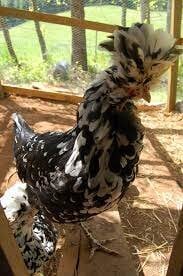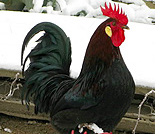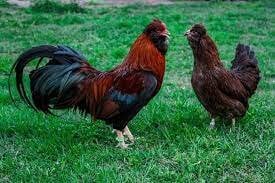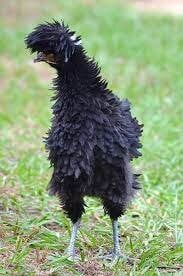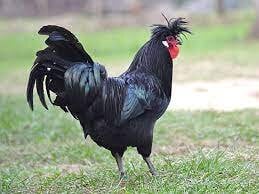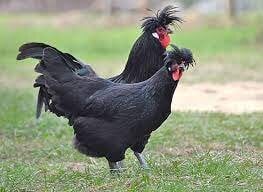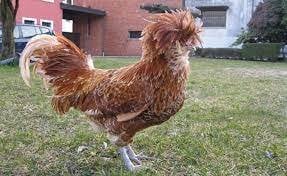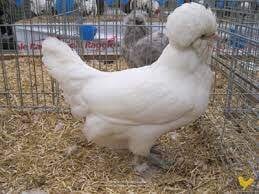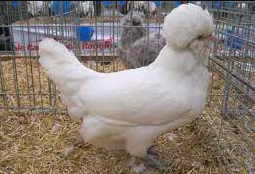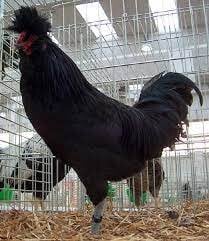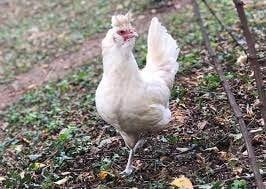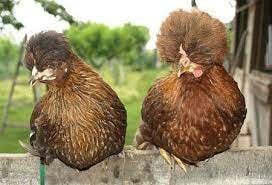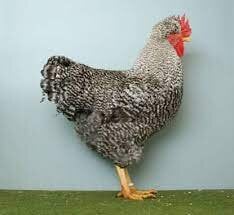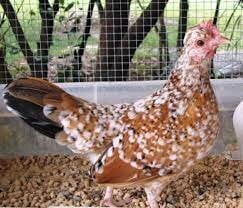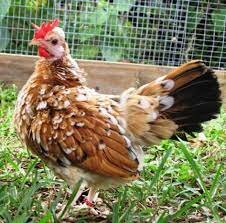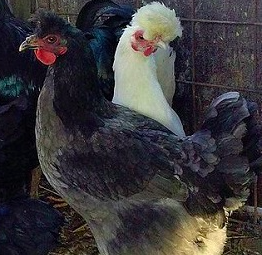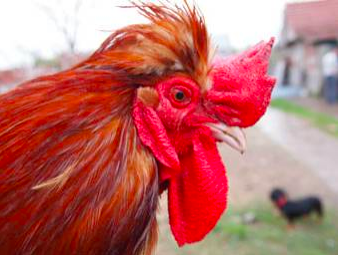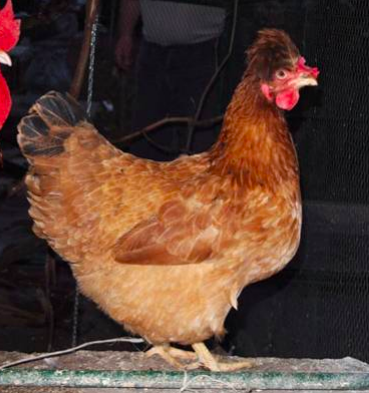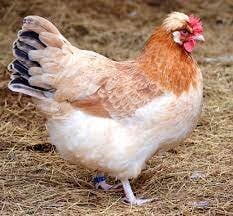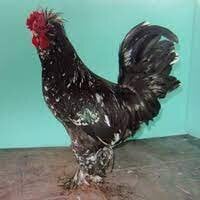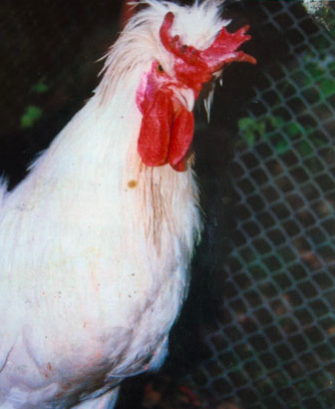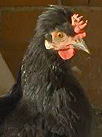Looking for a pretty chicken to buy? Want a pet to cuddle with? Or simply curious about crested breeds? Then this article is for you! I have compiled a guide of all crested chicken breeds (not including naked necks or extinct breeds, even if they’re being back-bred.) If you are looking to buy breeds, most crested breeds in this guide are extremely endangered, hard to find, expensive, or not for sale. Units are in the Imperial System and for chicken weights where there are both standard- and bantam-sized types only standard-sized are included. Tassel crest refers to a small crest that sweeps back. I hope you enjoy reading this article!
Altsteirer
Pronunciation: ALT-stire-er

Brown Altsteirer hen

Brown Altsteirer rooster
Alternate names: Styrian hen
Egg color: White or cream
Egg size or weight: Large
Eggs per year: 150-200
Purpose: Dual (eggs and meat)
Weight: Roosters around 2.2 - 6,6 pounds, hens around 5.5 pounds
Disposition and temperament: Altsteirers rarely go broody, and they love free-ranging
Description and facts: Altsteirers come in many different color varieties, including cuckoo, black breasted red, brown, and white. They have pink or yellow legs and medium-sized tassel crests. They have large red combs and wattles, and white earlobes
Place of origin: Styria, Austria
History: Altsteirers are related to Sulmtalers, but it is unclear how
Annaberg Crested
Pronunciation: A-nuh-berg CRESS-ted

Black-and-white mottled Annaberg Crested hen

Black Annaberg Crested rooster
Alternate names: Annaberger Crested, Annabergi Bóbitás, Annabergi Borzastyúkok, Anaberska Czubatka Szurpata, Anaberska Czubatka Lokowana, Annaberger Haubenstrupphühner, Frisée et Huppée d’Annaberg
Egg color: White or cream
Egg size or weight: Unknown
Eggs per year: 120
Purpose: Eggs
Weight: Roosters around 3.3 pounds, hens around 2.2 pounds
Disposition and temperament: Annaberg Cresteds are sweet, easily handled, and quiet. They are skittish and are good free-range birds, and also do well in confinement
Description and facts: Annaberg Cresteds can be black, black-and-white mottled, or white. They have medium-sized red wattles and pea combs, and slate legs. They have small, upright, and spiky crests
Place of origin: Annaberg, Germany
History: Annaberg Cresteds were bred in the Ore Mountains in Annaberg in 1957. They are related to Appenzeller Spitzhaubens, Brabanters, and Silkies
Appenzeller Spitzhauben

Silver Spangled Appenzeller Spitzhauben pullet from @Chickeroonie keeper

Silver Spangled Appenzeller Spitzhauben hen from @ShannonsChimkens

Silver Spangled Appenzeller Spitzhauben Rooster from @The-White-Elephant

Gold Spangled Appenzeller Spitzhauben hen from @ShannonsChimkens

Gold Spangled Appenzeller Spitzhauben rooster from @ShannonsChimkens
Pronunciation: APP-en-zell-er spits-HOW-bin
Photo
Alternate names: None
Egg color: White or cream
Egg size or weight: Medium
Eggs per year: 150-180
Purpose: Eggs and ornamental
Weight: Roosters around 5.5 pounds, hens around 4 pounds
Disposition and temperament: Appenzeller Spitzhaubens are great free-range birds and foragers. They like roaming and don’t tolerate confinement well, and like to roost in trees. They are good climbers, friendly, calm, active, and quiet. They also tolerate all climates
Description and facts: Appenzeller Spitzhaubens can be black, blue, chamois, gold spangled, lemon spangled, or silver spangled. They have white earlobes and slate legs. They have small red v-shaped combs and wattles. Spitzhauben means pointed bonnet, as they are named after Appenzellerland lace bonnets
Place of origin: Appenzell, Switzerland
History: Appenzeller Spitzhaubens have been around since the 1600s. They are thought to have been a cross of Brabanters, Crèvecœurs, and La Fleches
Barbu de Watermael
Pronunciation: BAR-boo day WA-ter-MAY-el

Quail Barbu de Watermael hen

White Barbu de Watermael rooster
Alternate names: None
Egg color: White or cream
Egg size or weight: Small
Eggs per year: 100
Purpose: Eggs and ornamental
Weight: Roosters around 1.3-1.4 pounds, hens around 1-1.2 pounds
Disposition and temperament: Barbu de Watermaels are calm, friendly, active, and sweet. They also do well in confinement, and are cold hardy
Description and facts: Barbu de Watermaels can be black, brown-red, buff, cuckoo, colombian, quail, or white. They have little to no red wattles and large rose combs. They have tassel crests and slate legs
Place of origin: Watermael-Boitsfort, Belgium
History: Barbu de Watermaels were bred in the early 1900s by Antoine Dresse
Brabançonne
Pronunciation: BRA-bon-sunn

Quail Brabançonne hen

Black Brabançonne rooster
Alternate names: None
Egg color: White or cream
Egg size or weight: 2.5 ounces
Eggs per year: 200
Purpose: Dual (eggs and meat)
Weight: Roosters around 5.5-6.6 pounds, hens around 4.4-5.5 pounds
Disposition and temperament: Brabançonnes rarely go broody. They are known for being excellent layers and start laying at around 4-5 months. They’re also very calm
Description and facts: Brabançonnes can be black, blue, quail, or white. The most popular color variety is quail, because it looks like the belgian flag: black neck, yellow breast, and red back. They have slate or blue legs and white earlobes. They have large red single combs and wattles. Their crests are large crests that sweep back. Interestingly, the crest is spikier in hens, whereas in most crested breeds roosters have spikier crests
Place of origin: Brabant, Netherlands
History: Brabançonnes were first bred in the mid-1800s, but they weren’t standardized until the late 1800s
Brabanter
Pronunciation: BRA-ban-ter

Gold Spangled Brabanter hen

Chamois Brabanter rooster
Alternate names: None
Egg color: White or cream
Egg size or weight: Large
Eggs per year: 150 - 200
Purpose: Dual (eggs and meat) and ornamental
Weight: Roosters around 4.2-5.5 pounds, hens around 3.5-4.4 pounds
Disposition and temperament: Brabanters are calm and smart, and confinement tolerant. They don’t tend to go broody, and they are good winter layers. They’re also sweet and docile, and like interacting with people
Description and facts: Brabanters can be black, blue, chamois, cuckoo, gold spangled, silver spangled, or white. They have small red wattles and v-shaped combs, and they have slate legs. They have medium-sized spiky upright crests
Place of origin: Brabant, Belgium and Netherlands
History: Brabanters have been around since the mid-1600s
Breda
Pronunciation: BREE-duh

Black Breda hen

Blue Breda rooster
Alternate names: Grueldre, Guelders, Guelderlands, Kraaikops
Egg color: White or cream
Egg size or weight: 2 ounces
Eggs per year: 180
Purpose: Eggs
Weight: Roosters around 6.5 pounds, hens around 5 pounds
Disposition and temperament: Bredas are calm, docile, and curious. They love to free-range, and they’re gentle and kid-friendly
Description and facts: Bredas can be black, blue, cuckoo, splash, or white. They have slate feathered legs and feet, red medium-sized wattles, and no comb. Bredas have tiny upright crests. Their other name, Kraaikops, means crow’s head in Dutch because of their unique head shape
Place of origin: Unknown
History: There is much debate about where Bredas originated, as they have been in the Netherlands for centuries but could also be from Belgium or France. They have been around since the mid-1600s
British Araucana
Pronunciation: BRI-tish are-a-CON-uh

Dark Partridge British Araucana hen from @JaeG

Dark Partridge British Araucana rooster from @JaeG
Alternate names: None
Egg color: Blue or green
Egg size or weight: Large
Eggs per year: 250
Purpose: Dual (eggs and meat)
Weight: Roosters around 6-7 pounds, hens around 5-6 pounds
Disposition and temperament: British Aracuanas are friendly and calm. They like free-ranging but also don’t mind confinement
Description and facts: British Araucanas can be Black, black-red, blue, blue-red, crele, cuckoo, golden duckwing, lavender, pile, silver duckwing, spangled, or white. They have small red wattles and pea combs, and slate legs. Hens have full tassel crests, and roosters have spiky tassel crests
Place of origin: Chile
History: British Araucanas were bred by George Malcolm in the 1930s
Bulgarian Bantam
Pronunciation: bull-GAH-ree-un BAN-tam

Black-and-white mottled Bulgarian bantam rooster(left) and hen(right)

Black-and-white mottled Bulgarian bantam hen
Alternate names: Bulgarska Dzhinka, Bregovska Dzhinka
Egg color: White or cream
Egg size or weight: 1 ounce
Eggs per year: 100-120
Purpose: Eggs
Weight: Roosters around 1.7-2.1 pounds, hens around 1.3-1.8 pounds
Disposition and temperament: Bulgarian bantams are very calm and tolerate all climates
Description and facts: Bulgarian bantams can be black-and-white mottled or porcelain. They have slate legs, as well as feathered legs and feet. They have red medium-sized wattles and single combs. Hens have medium-sized full and rounded crests, and roosters have medium-sized spiky and rounded crests
Place of origin: Northwestern Bulgaria (mainly Bregovo and Vidin)
History: History is unclear
Burmese Bantam
Pronunciation: bur-MEES BAN-tam

White Burmese bantam hen

White Burmese bantam rooster
Alternate names: None
Egg color: Brown
Egg size or weight:
Eggs per year: 150-160
Purpose: Eggs and ornamental
Weight: Roosters around 1.3 pounds, hens around 1 pound
Disposition and temperament: Burmese bantams are super calm and friendly. They are kid-friendly
Description and facts: Burmese bantams are white or wheaten with yellow feathered legs. They have small red wattles and single combs. Hens have small, full, and rounded crests that sweep back, and roosters have tassel crests
Place of origin: Myanmar
History: Burmese bantams were bred in the 1800s
Caumont
Pronunciation: COOH-mon

Caumont hen

Caumont rooster
Alternate names: None
Egg color: White or cream
Egg size or weight:
Eggs per year: 160-170
Purpose: Dual (eggs and meat)
Weight: Roosters around 6.6-7 pounds, hens around 5.5-6 pounds
Disposition and temperament: Caumonts are sweet, calm, and very cold hardy
Description and facts: Caumonts are black. They have large red wattles and buttercup combs, and they have slate legs. Hens have small full tassel crests, and roosters have small spiky tassel crests
Place of origin: Calvados, France
History: Caumonts are related to Crèvecœurs and Merleraults
Crested Legbar
Pronunciation: CRESS-ted LEG-bar

Crested Cream Legbar hen from @JustBabyMargo

Crested Golden Barred Legbar hen and rooster
Alternate names: Cream Legbar
Egg color: Blue or green
Egg size or weight: Medium
Eggs per year: 150-280
Purpose: Dual (eggs and meat)
Weight: Roosters around 6-7.5 pounds, hens around 4.4-6 pounds
Disposition and temperament: Crested Legbars are very friendly and social. They don’t like confinement much, and they are great free-rangers. They are alert, can defend themselves well, and are easy to handle
Description and facts: Crested Legbars can be cream barred, gold barred, or silver barred. They have yellow legs, and they have large red wattles and medium-sized single combs. Hens have medium-sized tassel crests, and roosters have small tassel crests
Place of origin: Cambridge, England
History: Crested Legbars were bred at Cambridge University by Reginald Punnett, Clarence Elliott, and Michael Pease
Crèvecœur
Pronunciation: crev-CUR

My Crèvecœur hen

Crèvecœur hen from @All4Eggz

Crèvecœur rooster from @CreveChris (go visit AuraHazeFarm.com!)
Alternate names: None
Egg color: White or cream
Egg size or weight: Medium
Eggs per year: 100-120
Purpose: Dual (eggs and meat)
Weight: Roosters around 8 pounds, hens around 6.5 pounds
Disposition and temperament: Crèvecœurs are quiet, docile, calm, friendly, and sweet. They do well in all climates. They like free-ranging but are also confinement tolerant
Description and facts: Crèvecœurs are black, and they have muffs and beards. They have small red wattles and medium-sized v-shaped combs, and they have slate legs. Hens have medium-sized rounded crests, and roosters have medium-sized spiky tassel crests
Place of origin: Crève-Cœur en Ange, France
History: Crèvecœurs have been around since the early 1800s. They are related to Caumont and Merlerault
Dalmatian
Pronunciation: dal-MAY-shin

Blue Dalmatian hen

Black Dalmatian hen(front) and rooster(back)
Alternate names: Dalmatinska Kokoks
Egg color: White or cream
Egg size or weight:
Eggs per year: 150
Purpose: Eggs
Weight: Roosters around 3.5-4.4, hens around 2.6-3.3 pounds
Disposition and temperament: Dalmatians are great foragers and free-range birds that were bred to do well in tough environments. They are extremely cold hardy, and are also calm
Description and facts: Dalmatians can be black, black-and-white mottled, blue, buff, duckwing, or partridge. They have large red wattles and single combs, and they have slate or willow legs. Hens have small full upright crests, and roosters have tassel crests
Place of origin: Dalmatia, Croatia
History: Dalmatians were likely bred centuries ago, but the earliest recordings of Dalmatians were in the 1900s
Greek Crested
Pronunciation: greek CRESS-ted

Greek Crested hen

Greek Crested rooster
Alternate names: Hooded Greek, Katsouliara, Skoufati
Egg color: Cream, light brown, brown, or white
Egg size or weight: Unknown
Eggs per year: Unknown
Purpose: Dual (eggs and meat)
Weight: Roosters around 6.6-8.8 pounds, hens around 4.4-6.6 pounds
Disposition and temperament: Greek Crested chickens are good free-range birds as well as good foragers. They are heat tolerant, and they are calm and quiet
Description and facts: Greek Cresteds are a landrace breed, so they all have different feathering and leg color. They have large red single combs and wattles, and they can have feathered legs. They have medium-sized crests that sweep back
Place of origin: Greece
History: History is unclear
Houdan
Pronunciation: OO-don

Black-and-white mottled Houdan hen from @JaeG

Black-and-white mottled Houdan chick from @Egg Snatcher

Black-and-white mottled Houdan rooster
Alternate names: None
Egg color: White or cream
Egg size or weight: Medium
Eggs per year: 150-180
Purpose: Dual (eggs and meat)
Weight: Roosters around 5.5-6.6 pounds, hens around 4.4-5.5 pounds
Disposition and temperament: Houdans are very sweet, calm, docile, and friendly. They tend to go broody, but aren’t known for being good mothers. They also aren’t cold hardy, and are flighty
Description and facts: Houdans are black-and-white mottled with feathered slate legs and 5 toes. They have small red wattles and v-shaped combs, and muffs and beards. Hens have large upright and full crests, and roosters have large tassel crests
Place of origin: Yvelines, France
History: Houdans have been around since before the 1700s. They are related to Crèvecœurs and Polish
Icelandic Crested
Pronunciation: ise-LAN-dic

Icelandic Crested hen

Icelandic Crested rooster
Alternate names: Haughænsni, íslenska hænan, Landnámshænan
Egg color: White or cream
Egg size or weight: Small
Eggs per year: 100-180
Purpose: Dual (eggs and meat)
Weight: Roosters around 4.5-5.25 pounds, hens around 3-3.5 pounds
Disposition and temperament: Icelandic Cresteds are hardy in all environments. They are great free-range birds and mostly self-sufficient, so they are a good choice for new chicken keepers. They are friendly, calm, and trusting. They don’t handle confinement well
Description and facts: Icelandic Cresteds are a landrace breed, so they all have different feathering, comb types, and leg color, although it is usually yellow. They have small tassel crests
Place of origin: Iceland
History: Icelandic Cresteds were bred by Norse settlers in the 9th century
Jitokko
Pronunciation: JEE-to-coh

Brown Partridge Jitokko hen

Brown Partridge Jitokko rooster
Alternate names: Japanese Creeper, Jitokkokagoshima
Egg color: Brown
Egg size or weight: Unknown
Eggs per year: Unknown
Purpose: Eggs
Weight: Roosters around 4.4-6.6 pounds, hens around 3.3-5.5 pounds
Disposition and temperament: Jitokkos are shy but sweet and docile. They are great free-range birds and aren’t very confinement tolerant
Description and facts: Jitokkos can be black partridge or brown partridge, and they have short yellow legs. They have small red single combs, and little to no wattles which are often hidden by their muffs and beards. Hens have medium-sized full crests that sweep back, and roosters have medium-sized spiky crests that sweep back
Place of origin: Kagoshima, Japan
History: Jitokkos were likely bred with Satsumadoris
Kosovo Longcrower
Pronunciation: KOH-soh-voh LONG-crow-er

Kosovo Longcrower hen

Kosovo Longcrower rooster
Alternate names: Drenica, Kosovski pevač
Egg color: White or cream
Egg size or weight: Large
Eggs per year: 160
Purpose: Dual (egg and meat) and crowing
Weight: Roosters around 4.4-7.2 pounds, hens around 3.3-4.4 pounds
Disposition and temperament: Kosovo Longcrowers are sweet, alert, and cold. They are great free-range birds, but don’t like confinement. After the first year of laying, Kosovo Longcrowers only lay 50-70 eggs per year. They are non-setters.
Description and facts: Kosovo Longcrowers are black with willow legs. They have large red wattles and small red v-shaped combs. Hens have medium-sized rounded upright crests that fall forward slightly, and roosters have medium-sized spiky upright crests
Place of origin: Drenica, Kosovo
History: The ancestors of Kosovo Longcrowers are believed to be Turkish longcrowing breeds. They were bred in the 1900s, and are closely related to Sanjak Longcrowers
Križevaci Crested
Pronunciation: KREE-jev-tsi CRESS-ted

Gold Laced Križevaci Crested hen

Gold Laced Križevaci Crested rooster
Alternate names: Križevacka Kukmasta Kokoš
Egg color: White or cream
Egg size or weight: 1.9 ounces
Eggs per year: Unknown
Purpose: Dual (egg and meat)
Weight: Roosters around 8.8-9.9 pounds, hens around 6.6-7.7 pounds
Disposition and temperament: Križevaci Cresteds are calm and docile. They make good mothers
Description and facts: Križevaci Cresteds can be buff or gold laced. They have large red wattles and single combs, and they have yellow legs. Hens have medium-sized rounded upright crests, and roosters have large spiky crests that sweep back
Place of origin: Krizhevtsi, Croatia
History: Križevaci Cresteds were bred recently, in the ‘90s. They were bred by Josip and Katica Vojta by crossing Orpingtons and local chickens
Lyonnaise
Pronunciation: lee-own-EZ

Black Frizzle Lyonnaise hen

Black Lyonnaise rooster
Alternate names: None
Egg color: White or cream
Egg size or weight: Medium
Eggs per year: Unknown
Purpose: Eggs
Weight: Roosters around 5.5 pounds, hens around 3.3 pounds
Disposition and temperament: Lyonnaise are super sweet, friendly, and submissive. They are also quiet, docile, calm, and good free-range birds. They also do well in confinement, and are heat and cold hardy
Description and facts: Lyonnaise are black, and can be frizzled or non-frizzled. They have slate legs, small red pea combs, and medium-sized red wattles. They have medium-sized crests that sweep forward
Place of origin: Lyon, France
History: Lyonnaise were bred by Etienne Tamburini in the 1950s, although they weren’t recognized as a breed until 1969. They were bred by crossing white Silkies, Dutch roosters, and Black Hamburg roosters
Thank you for reading my article! I’d love it if you could leave a rating, and I appreciate feedback. I think crested breeds are really interesting, and hopefully after reading this article you agree! I hope you learned something new! If you are interested, there is a part two (https://www.backyardchickens.com/articles/crested-chicken-breeds-guide-part-two.77183/) to this article as the article was too long to fit into one. Please consider checking that out as well!
Altsteirer
Pronunciation: ALT-stire-er
Brown Altsteirer hen
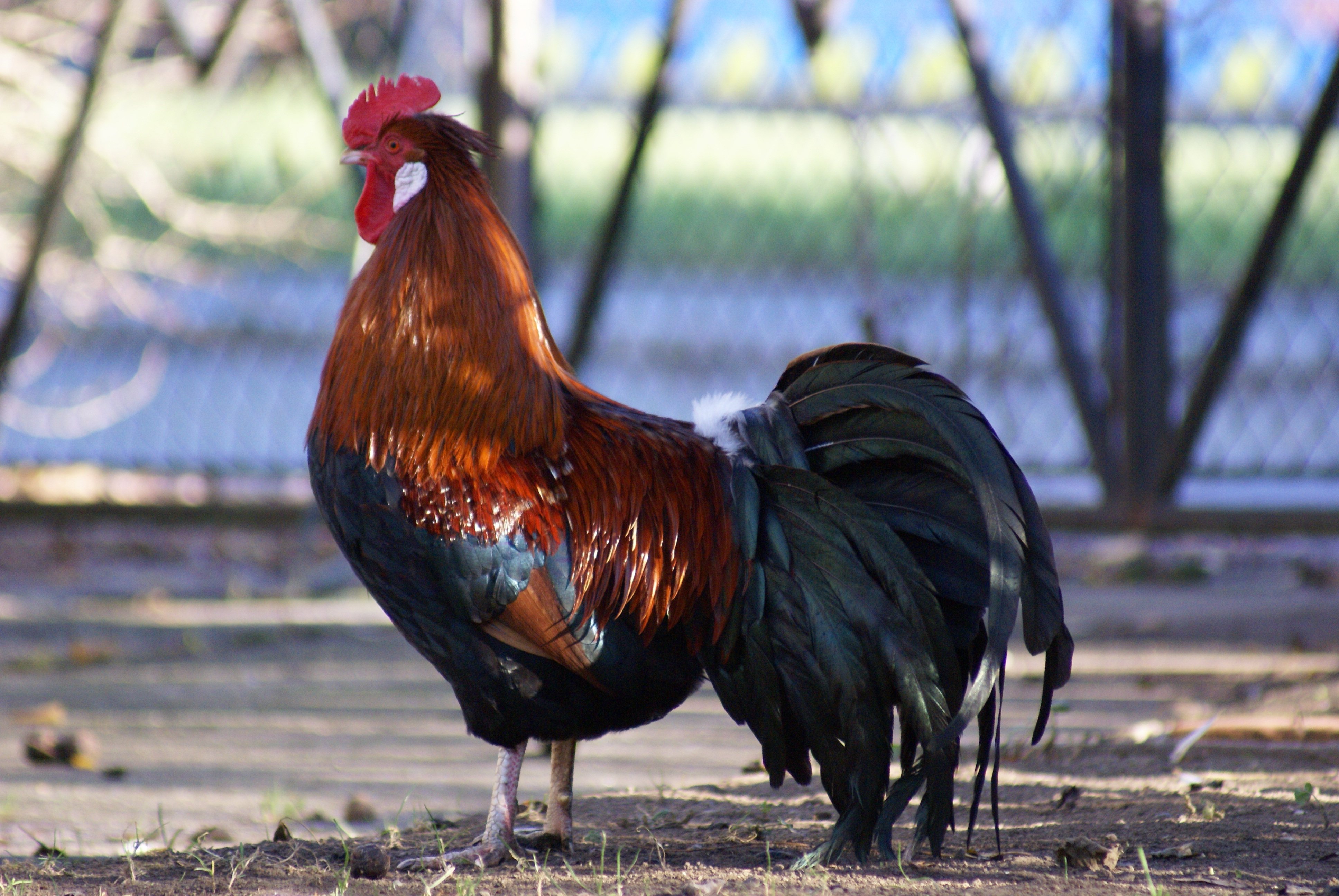
Brown Altsteirer rooster
Alternate names: Styrian hen
Egg color: White or cream
Egg size or weight: Large
Eggs per year: 150-200
Purpose: Dual (eggs and meat)
Weight: Roosters around 2.2 - 6,6 pounds, hens around 5.5 pounds
Disposition and temperament: Altsteirers rarely go broody, and they love free-ranging
Description and facts: Altsteirers come in many different color varieties, including cuckoo, black breasted red, brown, and white. They have pink or yellow legs and medium-sized tassel crests. They have large red combs and wattles, and white earlobes
Place of origin: Styria, Austria
History: Altsteirers are related to Sulmtalers, but it is unclear how
Annaberg Crested
Pronunciation: A-nuh-berg CRESS-ted
Black-and-white mottled Annaberg Crested hen
Black Annaberg Crested rooster
Alternate names: Annaberger Crested, Annabergi Bóbitás, Annabergi Borzastyúkok, Anaberska Czubatka Szurpata, Anaberska Czubatka Lokowana, Annaberger Haubenstrupphühner, Frisée et Huppée d’Annaberg
Egg color: White or cream
Egg size or weight: Unknown
Eggs per year: 120
Purpose: Eggs
Weight: Roosters around 3.3 pounds, hens around 2.2 pounds
Disposition and temperament: Annaberg Cresteds are sweet, easily handled, and quiet. They are skittish and are good free-range birds, and also do well in confinement
Description and facts: Annaberg Cresteds can be black, black-and-white mottled, or white. They have medium-sized red wattles and pea combs, and slate legs. They have small, upright, and spiky crests
Place of origin: Annaberg, Germany
History: Annaberg Cresteds were bred in the Ore Mountains in Annaberg in 1957. They are related to Appenzeller Spitzhaubens, Brabanters, and Silkies
Appenzeller Spitzhauben
Silver Spangled Appenzeller Spitzhauben pullet from @Chickeroonie keeper
Silver Spangled Appenzeller Spitzhauben hen from @ShannonsChimkens
Silver Spangled Appenzeller Spitzhauben Rooster from @The-White-Elephant
Gold Spangled Appenzeller Spitzhauben hen from @ShannonsChimkens
Gold Spangled Appenzeller Spitzhauben rooster from @ShannonsChimkens
Pronunciation: APP-en-zell-er spits-HOW-bin
Photo
Alternate names: None
Egg color: White or cream
Egg size or weight: Medium
Eggs per year: 150-180
Purpose: Eggs and ornamental
Weight: Roosters around 5.5 pounds, hens around 4 pounds
Disposition and temperament: Appenzeller Spitzhaubens are great free-range birds and foragers. They like roaming and don’t tolerate confinement well, and like to roost in trees. They are good climbers, friendly, calm, active, and quiet. They also tolerate all climates
Description and facts: Appenzeller Spitzhaubens can be black, blue, chamois, gold spangled, lemon spangled, or silver spangled. They have white earlobes and slate legs. They have small red v-shaped combs and wattles. Spitzhauben means pointed bonnet, as they are named after Appenzellerland lace bonnets
Place of origin: Appenzell, Switzerland
History: Appenzeller Spitzhaubens have been around since the 1600s. They are thought to have been a cross of Brabanters, Crèvecœurs, and La Fleches
Barbu de Watermael
Pronunciation: BAR-boo day WA-ter-MAY-el
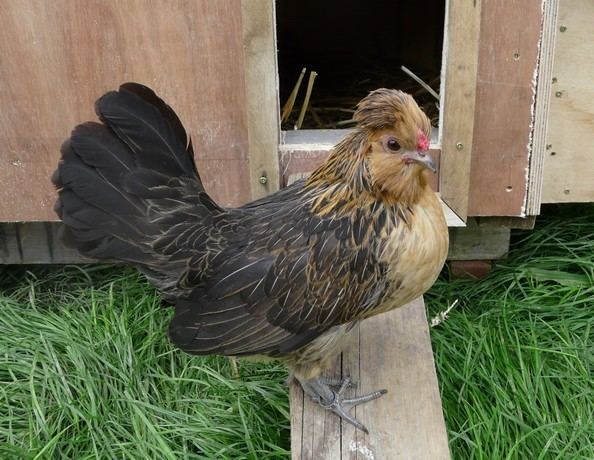
Quail Barbu de Watermael hen
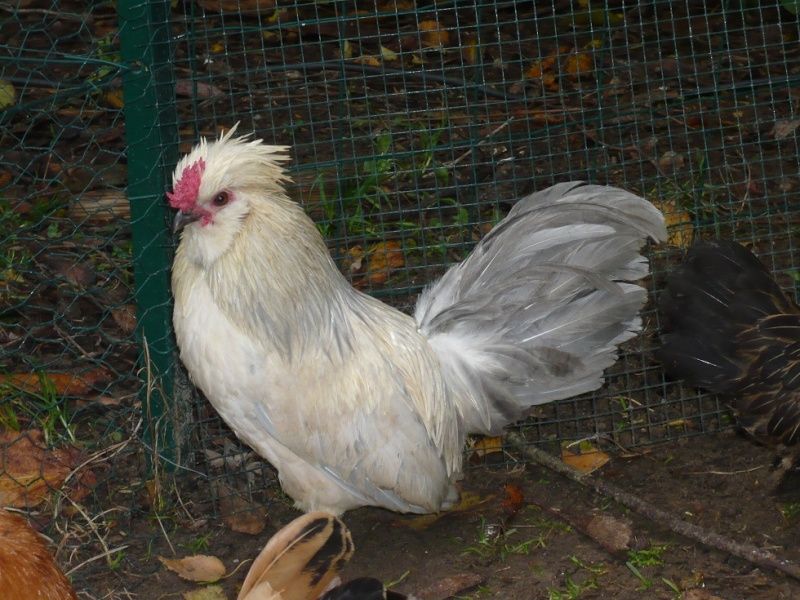
White Barbu de Watermael rooster
Alternate names: None
Egg color: White or cream
Egg size or weight: Small
Eggs per year: 100
Purpose: Eggs and ornamental
Weight: Roosters around 1.3-1.4 pounds, hens around 1-1.2 pounds
Disposition and temperament: Barbu de Watermaels are calm, friendly, active, and sweet. They also do well in confinement, and are cold hardy
Description and facts: Barbu de Watermaels can be black, brown-red, buff, cuckoo, colombian, quail, or white. They have little to no red wattles and large rose combs. They have tassel crests and slate legs
Place of origin: Watermael-Boitsfort, Belgium
History: Barbu de Watermaels were bred in the early 1900s by Antoine Dresse
Brabançonne
Pronunciation: BRA-bon-sunn
Quail Brabançonne hen
Black Brabançonne rooster
Alternate names: None
Egg color: White or cream
Egg size or weight: 2.5 ounces
Eggs per year: 200
Purpose: Dual (eggs and meat)
Weight: Roosters around 5.5-6.6 pounds, hens around 4.4-5.5 pounds
Disposition and temperament: Brabançonnes rarely go broody. They are known for being excellent layers and start laying at around 4-5 months. They’re also very calm
Description and facts: Brabançonnes can be black, blue, quail, or white. The most popular color variety is quail, because it looks like the belgian flag: black neck, yellow breast, and red back. They have slate or blue legs and white earlobes. They have large red single combs and wattles. Their crests are large crests that sweep back. Interestingly, the crest is spikier in hens, whereas in most crested breeds roosters have spikier crests
Place of origin: Brabant, Netherlands
History: Brabançonnes were first bred in the mid-1800s, but they weren’t standardized until the late 1800s
Brabanter
Pronunciation: BRA-ban-ter
Gold Spangled Brabanter hen
Chamois Brabanter rooster
Alternate names: None
Egg color: White or cream
Egg size or weight: Large
Eggs per year: 150 - 200
Purpose: Dual (eggs and meat) and ornamental
Weight: Roosters around 4.2-5.5 pounds, hens around 3.5-4.4 pounds
Disposition and temperament: Brabanters are calm and smart, and confinement tolerant. They don’t tend to go broody, and they are good winter layers. They’re also sweet and docile, and like interacting with people
Description and facts: Brabanters can be black, blue, chamois, cuckoo, gold spangled, silver spangled, or white. They have small red wattles and v-shaped combs, and they have slate legs. They have medium-sized spiky upright crests
Place of origin: Brabant, Belgium and Netherlands
History: Brabanters have been around since the mid-1600s
Breda
Pronunciation: BREE-duh
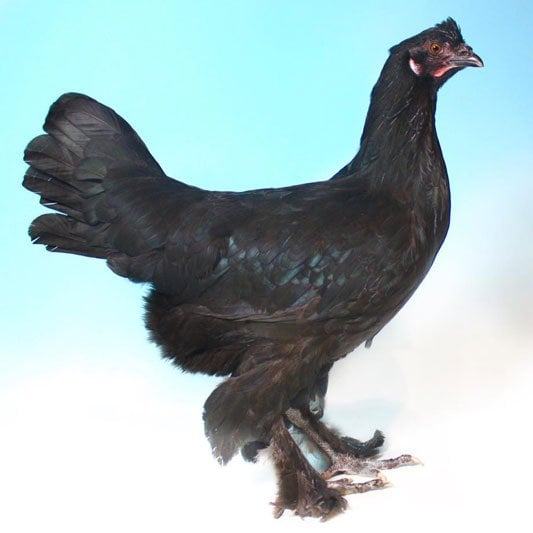
Black Breda hen

Blue Breda rooster
Alternate names: Grueldre, Guelders, Guelderlands, Kraaikops
Egg color: White or cream
Egg size or weight: 2 ounces
Eggs per year: 180
Purpose: Eggs
Weight: Roosters around 6.5 pounds, hens around 5 pounds
Disposition and temperament: Bredas are calm, docile, and curious. They love to free-range, and they’re gentle and kid-friendly
Description and facts: Bredas can be black, blue, cuckoo, splash, or white. They have slate feathered legs and feet, red medium-sized wattles, and no comb. Bredas have tiny upright crests. Their other name, Kraaikops, means crow’s head in Dutch because of their unique head shape
Place of origin: Unknown
History: There is much debate about where Bredas originated, as they have been in the Netherlands for centuries but could also be from Belgium or France. They have been around since the mid-1600s
British Araucana
Pronunciation: BRI-tish are-a-CON-uh
Dark Partridge British Araucana hen from @JaeG
Dark Partridge British Araucana rooster from @JaeG
Alternate names: None
Egg color: Blue or green
Egg size or weight: Large
Eggs per year: 250
Purpose: Dual (eggs and meat)
Weight: Roosters around 6-7 pounds, hens around 5-6 pounds
Disposition and temperament: British Aracuanas are friendly and calm. They like free-ranging but also don’t mind confinement
Description and facts: British Araucanas can be Black, black-red, blue, blue-red, crele, cuckoo, golden duckwing, lavender, pile, silver duckwing, spangled, or white. They have small red wattles and pea combs, and slate legs. Hens have full tassel crests, and roosters have spiky tassel crests
Place of origin: Chile
History: British Araucanas were bred by George Malcolm in the 1930s
Bulgarian Bantam
Pronunciation: bull-GAH-ree-un BAN-tam
Black-and-white mottled Bulgarian bantam rooster(left) and hen(right)
Black-and-white mottled Bulgarian bantam hen
Alternate names: Bulgarska Dzhinka, Bregovska Dzhinka
Egg color: White or cream
Egg size or weight: 1 ounce
Eggs per year: 100-120
Purpose: Eggs
Weight: Roosters around 1.7-2.1 pounds, hens around 1.3-1.8 pounds
Disposition and temperament: Bulgarian bantams are very calm and tolerate all climates
Description and facts: Bulgarian bantams can be black-and-white mottled or porcelain. They have slate legs, as well as feathered legs and feet. They have red medium-sized wattles and single combs. Hens have medium-sized full and rounded crests, and roosters have medium-sized spiky and rounded crests
Place of origin: Northwestern Bulgaria (mainly Bregovo and Vidin)
History: History is unclear
Burmese Bantam
Pronunciation: bur-MEES BAN-tam
White Burmese bantam hen

White Burmese bantam rooster
Alternate names: None
Egg color: Brown
Egg size or weight:
Eggs per year: 150-160
Purpose: Eggs and ornamental
Weight: Roosters around 1.3 pounds, hens around 1 pound
Disposition and temperament: Burmese bantams are super calm and friendly. They are kid-friendly
Description and facts: Burmese bantams are white or wheaten with yellow feathered legs. They have small red wattles and single combs. Hens have small, full, and rounded crests that sweep back, and roosters have tassel crests
Place of origin: Myanmar
History: Burmese bantams were bred in the 1800s
Caumont
Pronunciation: COOH-mon
Caumont hen
Caumont rooster
Alternate names: None
Egg color: White or cream
Egg size or weight:
Eggs per year: 160-170
Purpose: Dual (eggs and meat)
Weight: Roosters around 6.6-7 pounds, hens around 5.5-6 pounds
Disposition and temperament: Caumonts are sweet, calm, and very cold hardy
Description and facts: Caumonts are black. They have large red wattles and buttercup combs, and they have slate legs. Hens have small full tassel crests, and roosters have small spiky tassel crests
Place of origin: Calvados, France
History: Caumonts are related to Crèvecœurs and Merleraults
Crested Legbar
Pronunciation: CRESS-ted LEG-bar
Crested Cream Legbar hen from @JustBabyMargo

Crested Golden Barred Legbar hen and rooster
Alternate names: Cream Legbar
Egg color: Blue or green
Egg size or weight: Medium
Eggs per year: 150-280
Purpose: Dual (eggs and meat)
Weight: Roosters around 6-7.5 pounds, hens around 4.4-6 pounds
Disposition and temperament: Crested Legbars are very friendly and social. They don’t like confinement much, and they are great free-rangers. They are alert, can defend themselves well, and are easy to handle
Description and facts: Crested Legbars can be cream barred, gold barred, or silver barred. They have yellow legs, and they have large red wattles and medium-sized single combs. Hens have medium-sized tassel crests, and roosters have small tassel crests
Place of origin: Cambridge, England
History: Crested Legbars were bred at Cambridge University by Reginald Punnett, Clarence Elliott, and Michael Pease
Crèvecœur
Pronunciation: crev-CUR
My Crèvecœur hen
Crèvecœur hen from @All4Eggz
Crèvecœur rooster from @CreveChris (go visit AuraHazeFarm.com!)
Alternate names: None
Egg color: White or cream
Egg size or weight: Medium
Eggs per year: 100-120
Purpose: Dual (eggs and meat)
Weight: Roosters around 8 pounds, hens around 6.5 pounds
Disposition and temperament: Crèvecœurs are quiet, docile, calm, friendly, and sweet. They do well in all climates. They like free-ranging but are also confinement tolerant
Description and facts: Crèvecœurs are black, and they have muffs and beards. They have small red wattles and medium-sized v-shaped combs, and they have slate legs. Hens have medium-sized rounded crests, and roosters have medium-sized spiky tassel crests
Place of origin: Crève-Cœur en Ange, France
History: Crèvecœurs have been around since the early 1800s. They are related to Caumont and Merlerault
Dalmatian
Pronunciation: dal-MAY-shin
Blue Dalmatian hen
Black Dalmatian hen(front) and rooster(back)
Alternate names: Dalmatinska Kokoks
Egg color: White or cream
Egg size or weight:
Eggs per year: 150
Purpose: Eggs
Weight: Roosters around 3.5-4.4, hens around 2.6-3.3 pounds
Disposition and temperament: Dalmatians are great foragers and free-range birds that were bred to do well in tough environments. They are extremely cold hardy, and are also calm
Description and facts: Dalmatians can be black, black-and-white mottled, blue, buff, duckwing, or partridge. They have large red wattles and single combs, and they have slate or willow legs. Hens have small full upright crests, and roosters have tassel crests
Place of origin: Dalmatia, Croatia
History: Dalmatians were likely bred centuries ago, but the earliest recordings of Dalmatians were in the 1900s
Greek Crested
Pronunciation: greek CRESS-ted
Greek Crested hen

Greek Crested rooster
Alternate names: Hooded Greek, Katsouliara, Skoufati
Egg color: Cream, light brown, brown, or white
Egg size or weight: Unknown
Eggs per year: Unknown
Purpose: Dual (eggs and meat)
Weight: Roosters around 6.6-8.8 pounds, hens around 4.4-6.6 pounds
Disposition and temperament: Greek Crested chickens are good free-range birds as well as good foragers. They are heat tolerant, and they are calm and quiet
Description and facts: Greek Cresteds are a landrace breed, so they all have different feathering and leg color. They have large red single combs and wattles, and they can have feathered legs. They have medium-sized crests that sweep back
Place of origin: Greece
History: History is unclear
Houdan
Pronunciation: OO-don
Black-and-white mottled Houdan hen from @JaeG
Black-and-white mottled Houdan chick from @Egg Snatcher
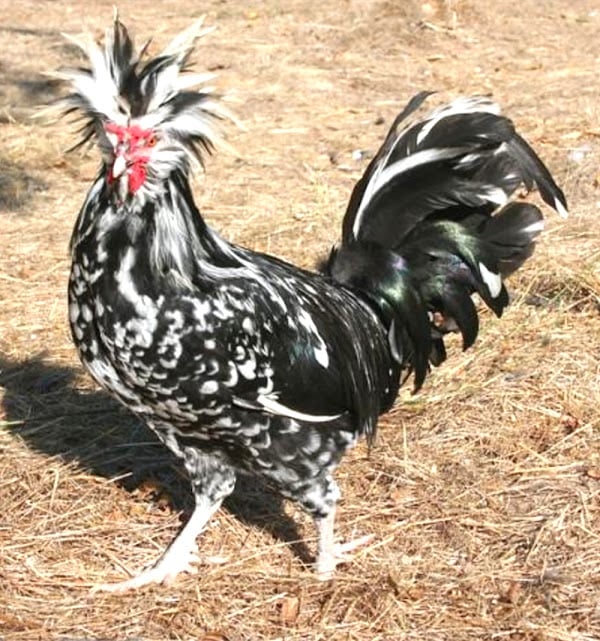
Black-and-white mottled Houdan rooster
Alternate names: None
Egg color: White or cream
Egg size or weight: Medium
Eggs per year: 150-180
Purpose: Dual (eggs and meat)
Weight: Roosters around 5.5-6.6 pounds, hens around 4.4-5.5 pounds
Disposition and temperament: Houdans are very sweet, calm, docile, and friendly. They tend to go broody, but aren’t known for being good mothers. They also aren’t cold hardy, and are flighty
Description and facts: Houdans are black-and-white mottled with feathered slate legs and 5 toes. They have small red wattles and v-shaped combs, and muffs and beards. Hens have large upright and full crests, and roosters have large tassel crests
Place of origin: Yvelines, France
History: Houdans have been around since before the 1700s. They are related to Crèvecœurs and Polish
Icelandic Crested
Pronunciation: ise-LAN-dic

Icelandic Crested hen

Icelandic Crested rooster
Alternate names: Haughænsni, íslenska hænan, Landnámshænan
Egg color: White or cream
Egg size or weight: Small
Eggs per year: 100-180
Purpose: Dual (eggs and meat)
Weight: Roosters around 4.5-5.25 pounds, hens around 3-3.5 pounds
Disposition and temperament: Icelandic Cresteds are hardy in all environments. They are great free-range birds and mostly self-sufficient, so they are a good choice for new chicken keepers. They are friendly, calm, and trusting. They don’t handle confinement well
Description and facts: Icelandic Cresteds are a landrace breed, so they all have different feathering, comb types, and leg color, although it is usually yellow. They have small tassel crests
Place of origin: Iceland
History: Icelandic Cresteds were bred by Norse settlers in the 9th century
Jitokko
Pronunciation: JEE-to-coh
Brown Partridge Jitokko hen
Brown Partridge Jitokko rooster
Alternate names: Japanese Creeper, Jitokkokagoshima
Egg color: Brown
Egg size or weight: Unknown
Eggs per year: Unknown
Purpose: Eggs
Weight: Roosters around 4.4-6.6 pounds, hens around 3.3-5.5 pounds
Disposition and temperament: Jitokkos are shy but sweet and docile. They are great free-range birds and aren’t very confinement tolerant
Description and facts: Jitokkos can be black partridge or brown partridge, and they have short yellow legs. They have small red single combs, and little to no wattles which are often hidden by their muffs and beards. Hens have medium-sized full crests that sweep back, and roosters have medium-sized spiky crests that sweep back
Place of origin: Kagoshima, Japan
History: Jitokkos were likely bred with Satsumadoris
Kosovo Longcrower
Pronunciation: KOH-soh-voh LONG-crow-er
Kosovo Longcrower hen

Kosovo Longcrower rooster
Alternate names: Drenica, Kosovski pevač
Egg color: White or cream
Egg size or weight: Large
Eggs per year: 160
Purpose: Dual (egg and meat) and crowing
Weight: Roosters around 4.4-7.2 pounds, hens around 3.3-4.4 pounds
Disposition and temperament: Kosovo Longcrowers are sweet, alert, and cold. They are great free-range birds, but don’t like confinement. After the first year of laying, Kosovo Longcrowers only lay 50-70 eggs per year. They are non-setters.
Description and facts: Kosovo Longcrowers are black with willow legs. They have large red wattles and small red v-shaped combs. Hens have medium-sized rounded upright crests that fall forward slightly, and roosters have medium-sized spiky upright crests
Place of origin: Drenica, Kosovo
History: The ancestors of Kosovo Longcrowers are believed to be Turkish longcrowing breeds. They were bred in the 1900s, and are closely related to Sanjak Longcrowers
Križevaci Crested
Pronunciation: KREE-jev-tsi CRESS-ted
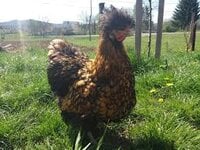
Gold Laced Križevaci Crested hen
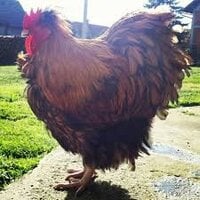
Gold Laced Križevaci Crested rooster
Alternate names: Križevacka Kukmasta Kokoš
Egg color: White or cream
Egg size or weight: 1.9 ounces
Eggs per year: Unknown
Purpose: Dual (egg and meat)
Weight: Roosters around 8.8-9.9 pounds, hens around 6.6-7.7 pounds
Disposition and temperament: Križevaci Cresteds are calm and docile. They make good mothers
Description and facts: Križevaci Cresteds can be buff or gold laced. They have large red wattles and single combs, and they have yellow legs. Hens have medium-sized rounded upright crests, and roosters have large spiky crests that sweep back
Place of origin: Krizhevtsi, Croatia
History: Križevaci Cresteds were bred recently, in the ‘90s. They were bred by Josip and Katica Vojta by crossing Orpingtons and local chickens
Lyonnaise
Pronunciation: lee-own-EZ
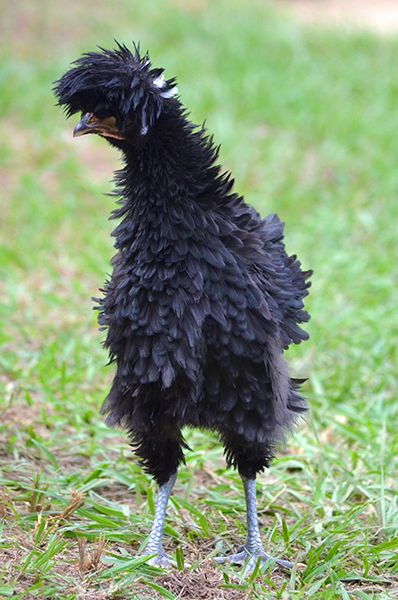
Black Frizzle Lyonnaise hen
Black Lyonnaise rooster
Alternate names: None
Egg color: White or cream
Egg size or weight: Medium
Eggs per year: Unknown
Purpose: Eggs
Weight: Roosters around 5.5 pounds, hens around 3.3 pounds
Disposition and temperament: Lyonnaise are super sweet, friendly, and submissive. They are also quiet, docile, calm, and good free-range birds. They also do well in confinement, and are heat and cold hardy
Description and facts: Lyonnaise are black, and can be frizzled or non-frizzled. They have slate legs, small red pea combs, and medium-sized red wattles. They have medium-sized crests that sweep forward
Place of origin: Lyon, France
History: Lyonnaise were bred by Etienne Tamburini in the 1950s, although they weren’t recognized as a breed until 1969. They were bred by crossing white Silkies, Dutch roosters, and Black Hamburg roosters
Thank you for reading my article! I’d love it if you could leave a rating, and I appreciate feedback. I think crested breeds are really interesting, and hopefully after reading this article you agree! I hope you learned something new! If you are interested, there is a part two (https://www.backyardchickens.com/articles/crested-chicken-breeds-guide-part-two.77183/) to this article as the article was too long to fit into one. Please consider checking that out as well!

